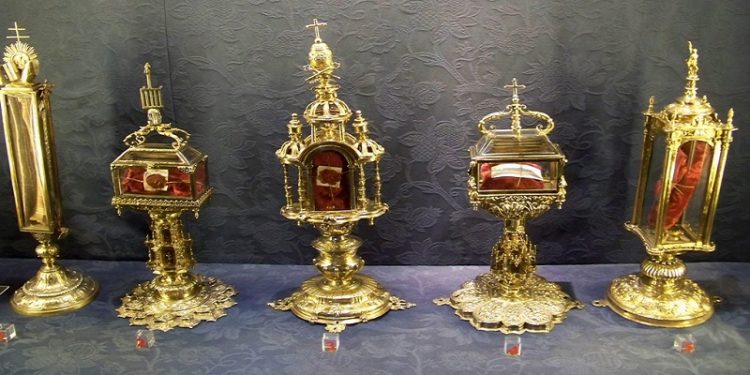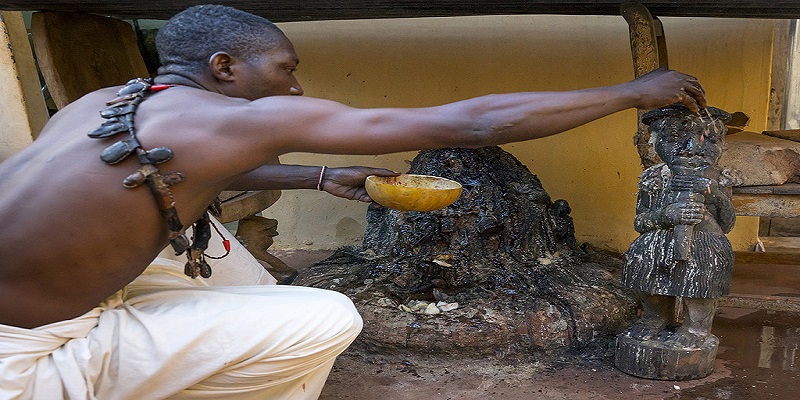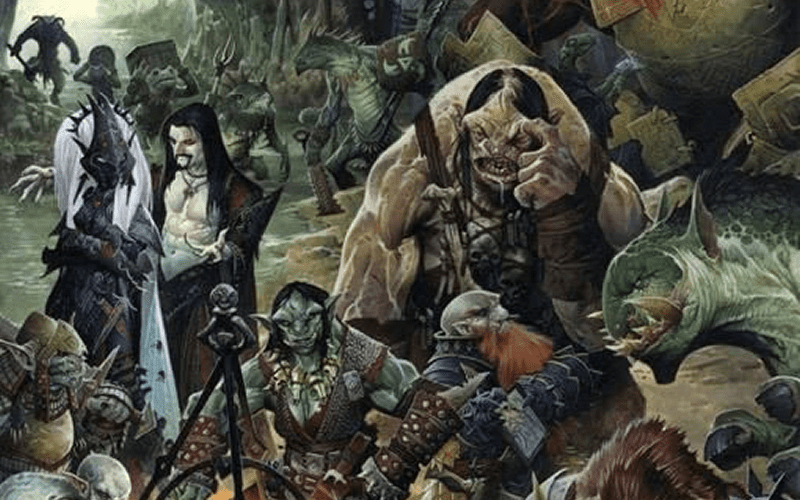Using Religion in your Games P4

For the most part, religions and belief systems are things we experience as a mostly passive participant in their development in our daily lives. Many of us are indoctrinated into a religion or belief system from an early age, being exposed to the figures of the faith; relics, reliquaries, and fetishes; holy places; and liturgy which we accepted without question. Unless we take the time to sit down and question what we believe or have an opportunity to take a “comparative religions” class, we stick with that selfsame beliefs. The reason for this may be as simple as “I grew up with this, therefore I am comfortable with it” to as complex as “I have done the research, the soul searching, as well as the thought and behavioral modifications this religion requires of its adherents and I feel that it is the truth.”
But what is a religion? Let’s use the following definition:
Religion may be defined as a cultural system of designated behaviors and practices, worldviews, texts, sanctified places, prophecies, ethics, or organizations, that relates humanity to supernatural, transcendental, or spiritual elements. They may or may not contain various elements ranging from the divine, sacred things, faith, a supernatural being or supernatural beings or transcendence. Religious practices may include rituals, sermons, commemoration or veneration (of deities), sacrifices, festivals, feasts, trances, initiations, funerary and matrimonial services, meditation, prayer, music, art, dance, public service, or other aspects of human culture. Religions have sacred histories and narratives, which may be preserved in sacred scriptures, and symbols and holy places, that aim mostly to give a meaning to life. Religions may contain symbolic stories, which are sometimes said by followers to be true, that have the side purpose of explaining the origin of life, the universe, and other things. Traditionally, faith, in addition to reason, has been considered a source of religious beliefs.
Figures of the Faith
Figures of the faith can fall into one of several categories:
- Deities: these are the god or gods of the faith. Keep in mind in an RPG game, these may be simply the gods that align themselves with the god a particular character serves, excluding any gods the deity in question opposes.
- Demons: these are the enemies of the faith, whether actual “demons” or not, as well as creatures or monsters that the god(s) oppose.
- Saints: these are the figures that have done well according to the god(s) wishes
- Sinners: these are the figures that have acted against the will of the god(s)
- Apostates: these are the figures that once were a part of the faith and now either actively oppose it or no longer believe in it.
It should be noted that in the real world, Christianity has an interesting duality. Christians are seen to be simultaneously “saint and sinner.” Such a duality might work in the gaming world as well, if there’s the concept of sin and salvation.
Some questions to ask yourself when dealing with the figures of the faith
- Why are these figures so well known? What did they do in their lives? Are they still alive?
- What do myths and legends say about the various figures? Is there a difference between these sources and what actually happened? What is the difference?
- What’s so bad about not doing what the god(s) want?
- As far as the “demons” go, why are they so bad? Is it a thing of active choice or is it something so in-bred in them, they have to fight their inclinations to do the “right thing?” Or is their very existence evil?
Relics, Reliquaries, & Fetishes
Relics
Relics are the physical remains of a holy site or holy person, or objects with which they had contact. The idea is as old as faith itself and developed alongside it. Relics are considered to be more than mementos. In the Christian faith, the New Testament refers to object’s healing power that were touched by Christ or his apostles. In Catholicism (and to a much lesser extent, Protestantism), the body of the saint provided a spiritual link between life and death, between man and the divine. In both the real world and a fantasy setting, relics are priceless treasures for the congregations of the faithful that are able to obtain them. You might even see one church stealing a relic from another to gain its power or prestige. Because many fantasy settings are an echo of the real-world time era of the Middle ages, a good source of inspiration for how you might be able to use a catholic type religion is found in Kate Elliott’s Crown of Stars series.
Reliquaries
Reliquaries are the containers that store and display relics. Most of the time, these relics are specifically made for and paid churches. More rarely, some were made for or paid for by privileged individuals for private use in home chapels. Since the relics themselves were considered “more valuable than precious stones and more to be esteemed than gold,” it was considered only appropriate that they be enshrined in vessels (reliquaries) crafted of or covered by gold, silver, ivory, gems, and enamel which frequently assume the form of caskets or parts of the body reflecting the relics they enshrined. They could be decorated with either narrative scenes from the life of saints or common themes of the faith. Some reliquaries were also fashioned into full-body statues, or more abbreviated, but still imposing, bust-length images of saints. Set on an altar and carried in a trumpet-heralded procession, a reliquary’s arrival is able to make an indelible impression on the faithful. However, despite their popularity and veneration, in modern times not many survive. This is due to many of them were destroyed during times of religious and political strife. Those that survive bear precious witness to exceptional artistic creativity inspired by contemporary faith.
Fetishes
Fetishes in religious context are expressed as objects believed to have supernatural powers, or in particular, a human-made object that has power over others, particularly to avoid harm or disease that said fetish is being used on. Fetishes always consists of two components: the material object and the force or power that gives it life, typically an animal spirit, force of spirit, or ancestor. Culturally, in the real world, the use of fetishes derives from either West African or Native American religious beliefs (which would be called Totems / Totem Poles today.) In your game you could have fetishes contain powers that the PCs and NPCs can call on in a time of need.
Consider these questions when designing fetishes in your game:
- What is the purpose of the fetish?
- What is empowering the fetish?
- Who was it originally made by?
- What are the fetish’s powers?
- What does it look like? Is it a large or small object? What is it made of Is it meant to protect an individual or a large area, for instance a house or town?
- When was it made?

Holy Sites
Holy places are sites that religions considers to be of special religious significance. Holy places are often visited by pilgrims. Some real-world holy sites are:
- The Baha’i venerate the Shrine of Bahá’u’lláh, which is located in Bahji near Acre, Israel.
- Buddhism think that the Bodhi Tree, where it is believed Buddha realized enlightenment, located in Bodh Gaya, India, is the most important religious site and place of pilgrimage.
- Both Christianity and Judaism consider Jerusalem to be holy. In Christianity, Jerusalem is believed to be the site of some of Jesus’s teaching, the Last Supper, the subsequent institution of the Holy Eucharist as well as his entombment; Christians believe he was crucified on a nearby hill, Golgotha (sometimes called Calvary). It contains the Church of the Holy Sepulchre, Via Dolorosa, Mount Zion and the Dormition Abbey, and Gethsemane (with Mary’s Tomb and the Church of All Nations). Judaism consider it the holiest city, focus and their spiritual center. The location has long been embedded into Jewish religious consciousness and Jews have always studied and personalized the struggle by King David to capture Jerusalem and his desire to build the Holy Temple there, as described in the Book of Samuel and the Book of Psalms.
- Stonehenge is a site of religious significance in Neo-Druidism. Druids perform pilgrimage there, The first modern Druids to make ceremonies at this site is the Ancient Order of Druids.
- Four sacred mountains of Taoism:
- Wudang Mountains, in Shiyan, Hubei Province of China;
- Mount Qingcheng, in Dujiangyan, Sichuan Province;
- Mount Longhu, in Yingtan, Jiangxi Province;
- Mount Qiyun, in Huangshan, Anhui Province.
For a complete list of real-world holy sites, see here.
Here are some questions to ask yourself when creating holy sites for your game world… or even a specific locale within it.
- What happened here? What makes it special or unique among the hundreds (or possibly even thousands) of sites that someone could visit? Why this site?
- Who are the pilgrims that visit it? What do they seek to gain from traveling here?
- When do these pilgrimages take place? How often do they happen?
- Where is it? Is it in the middle of a city? Is it the top of the mountain where the hermit dwells? Is it a hidden room in a dungeon? Why is it here?
Liturgy
Liturgy is the customary public worship performed by a religious group, representing a communal response to and participation in the sacred through activity reflecting praise, thanksgiving, supplication, or repentance. In real life it encompasses such things as processionals with incense and a crucifix, Eucharistic prayers, or the Communion Rite, Vestments, incense, music, and devotions to patron saints. It forms a basis for establishing a relationship with a divine agency, as well as with other participants (i.e. congregational members). Worship (whether in real life or in an RPG game) is meant to bring one closer to that which they worship: divine (or other) forces, giving give those worshipping a taste or glimpse of the afterlife, a perfect world, or a world where the divinity they are worshipping reigns supreme. Those creating and in charge of adapting liturgical experiences to each congregation should keep in mind the audience’s needs, as if it can’t adapt, the temple or church will soon lose worshippers.
There are a variety of ways to use religion in your games. Figures of the faith; relics, reliquaries, and fetishes, holy sites and liturgy help ground your gaming world with touchstones that we see in our everyday experiences. Use these ideas to help make religions more realistic in your game.



